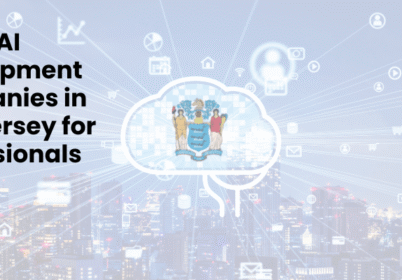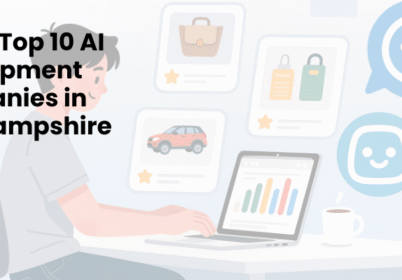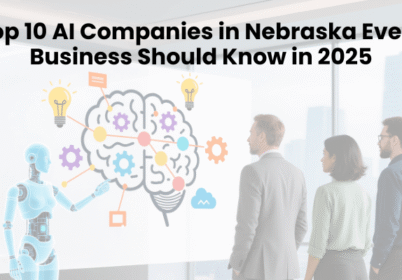The Role of AI in Modern Product Development
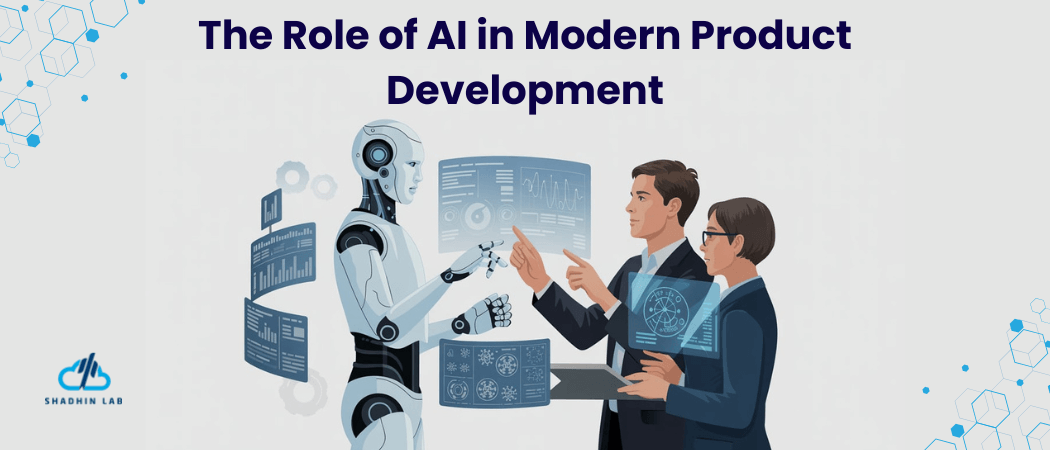
Table of Contents
Artificial Intelligence is revolutionizing product development across industries. According to McKinsey, AI has reduced cycle times by up to 70%. Organizations using AI in product development are seeing major gains in efficiency, innovation, and market responsiveness. Its integration marks a fundamental shift in how companies design, test, and launch new offerings.
This shift goes beyond automating routine tasks. AI allows teams to analyze large datasets, generate design concepts, predict market responses, and optimize manufacturing. These tools are also democratizing capabilities once limited to resource-rich firms. However, success requires strategic planning, the right tools, and alignment with human expertise.
This guide explores how AI is reshaping both physical and digital product development. We’ll look at practical approaches, real-world case studies, and actionable frameworks. We’ll also address challenges, best practices, and how to measure ROI from AI in product development.
Table of Contents
What is AI in Product Development? Understanding the Fundamentals
AI in product development refers to the application of artificial intelligence technologies throughout the product lifecycle. This integration enhances human capabilities rather than replacing them entirely. The fundamental goal involves leveraging machine learning, natural language processing, computer vision, and other AI technologies to improve product creation processes.
At its core, AI augments human creativity and decision-making by processing vast amounts of data at unprecedented speeds. For instance, generative AI systems can produce hundreds of design variations based on specific parameters in minutes. Traditional approaches might require weeks of manual work to achieve similar results.
The scope of AI application spans the entire product development cycle. In the research phase, AI analyzes market trends, customer feedback, and competitive landscapes. During conceptualization, generative AI creates design options based on specified constraints and objectives. Throughout testing, AI simulates product performance under various conditions without physical prototyping.
Furthermore, AI optimizes manufacturing processes by predicting potential issues before production begins. This comprehensive integration transforms product development from a primarily human-driven process to a collaborative human-AI partnership. The result is faster development cycles, more innovative products, and better market alignment.
Companies like Tesla, Apple, and Procter & Gamble have integrated AI throughout their product development processes. These organizations report significant improvements in development speed, cost reduction, and innovation quality. Moreover, AI enables smaller companies to compete more effectively by accessing capabilities previously available only to larger enterprises.
Types of AI Technologies in Product Development
Multiple AI technologies contribute to modern product development processes. Machine learning algorithms analyze historical data to identify patterns and make predictions about future product performance. Natural language processing interprets customer feedback, reviews, and support tickets to identify improvement opportunities.
Computer vision technologies inspect product components for defects with greater accuracy than human inspection. Generative AI creates novel design concepts based on specified parameters and constraints. Reinforcement learning optimizes manufacturing processes through continuous improvement cycles.
Predictive analytics forecasts market demand, potential supply chain disruptions, and maintenance needs. Knowledge graphs connect disparate information sources to provide comprehensive context for decision-making. Each technology addresses specific aspects of the product development process.
The most effective implementations combine multiple AI technologies to create comprehensive solutions. For example, a furniture manufacturer might use computer vision to inspect materials, generative AI to create design options, and predictive analytics to optimize inventory management. This integrated approach maximizes the transformative potential of AI in product development.
| AI Technology | Primary Application in Product Development | Key Benefits |
| Machine Learning | Predictive analytics, pattern recognition | Identifies trends and opportunities from historical data |
| Generative AI | Design concept creation, variation generation | Produces numerous design options rapidly |
| Natural Language Processing | Customer feedback analysis, requirement extraction | Converts unstructured text into actionable insights |
| Computer Vision | Quality inspection, visual design analysis | Detects defects and analyzes visual patterns |
| Reinforcement Learning | Process optimization, testing simulations | Improves processes through continuous learning |
How AI is Transforming the Product Development Lifecycle
AI is fundamentally reshaping each phase of the product development lifecycle. In the research and discovery phase, AI analyzes vast amounts of market data, customer feedback, and competitive intelligence. This analysis reveals unmet needs and emerging opportunities that might otherwise remain hidden.
During concept development, generative AI creates multiple design options based on specified parameters. For instance, Autodesk’s generative design software produced a lightweight aircraft partition that reduced weight by 45% while maintaining structural integrity. This approach enables exploration of design spaces beyond human imagination.
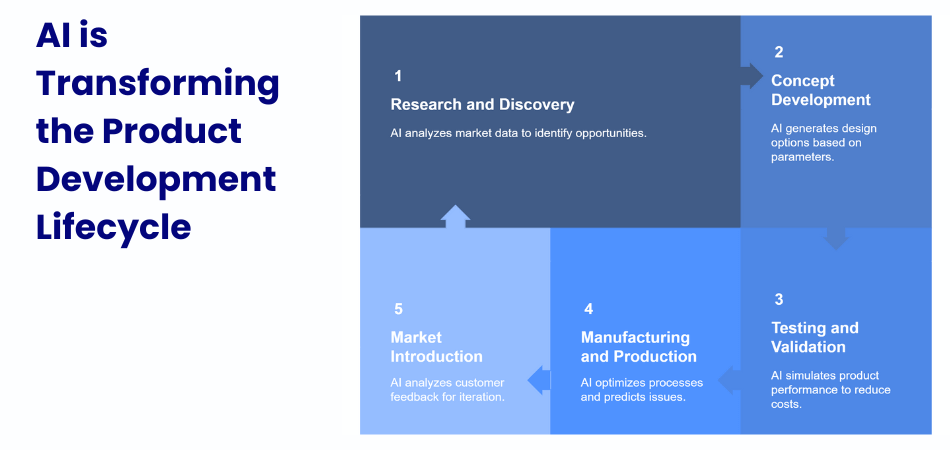
In the testing and validation phase, AI simulates product performance under various conditions. These simulations reduce the need for physical prototypes, cutting development time and costs significantly. Companies like Siemens report 60% faster testing cycles through AI-powered simulation tools.
Throughout manufacturing and production, AI optimizes processes and predicts potential issues before they occur. Predictive maintenance systems reduce downtime by identifying equipment problems before failure. Additionally, AI quality control systems detect defects with greater accuracy than human inspection.
In the market introduction phase, AI analyzes customer responses and enables rapid iteration. This continuous feedback loop allows companies to refine products based on real-world usage data. Furthermore, AI-powered analytics help identify new market segments and applications for existing products.
AI in Product Research and Discovery
AI transforms the initial research phase by analyzing diverse data sources to identify opportunities. Natural language processing examines social media conversations, reviews, and forum discussions to uncover unmet customer needs. This approach provides deeper insights than traditional market research methods.
Competitive intelligence tools powered by AI monitor competitor activities across digital channels. These tools identify emerging trends, pricing strategies, and feature innovations. Furthermore, AI analyzes patent filings and academic research to highlight technological developments relevant to product innovation.
Sentiment analysis evaluates emotional responses to existing products, revealing improvement opportunities. Visual analytics tools identify design trends and preferences across market segments. Additionally, AI systems can predict which product features will drive the greatest customer satisfaction and loyalty.
Companies like P&G use AI to analyze billions of consumer interactions, identifying subtle patterns that inform new product development. This approach has led to successful innovations like Tide Pods, which addressed unrecognized consumer pain points. The result is more targeted product development with higher success rates.
AI-Powered Product Design and Concept Development
Generative AI is revolutionizing product design by creating numerous concept variations based on specified parameters. Systems like Autodesk’s generative design software produce options that human designers might never conceive. These systems optimize for multiple factors simultaneously, including performance, cost, and manufacturability.
For physical products, AI analyzes materials, structural integrity, and manufacturing constraints. Airbus used generative design to create aircraft partition walls that reduced weight by 45% while maintaining structural requirements. This approach combines human creativity with computational optimization capabilities.
In digital product development, AI analyzes user behavior patterns to inform interface design. Companies like Netflix continuously optimize their user interface based on AI-driven insights. These optimizations improve user engagement and satisfaction through data-driven design decisions.
AI also enables rapid prototyping through visualization technologies. Designers can quickly generate realistic renderings of concepts without building physical prototypes. Furthermore, augmented reality applications allow stakeholders to experience product concepts in realistic contexts before development begins.
The collaboration between human designers and AI systems creates a powerful partnership. Humans provide creative direction and contextual understanding, while AI generates options and optimizes for specific constraints. This collaboration leads to more innovative, efficient, and effective product designs.
Case Study: General Motors’ AI-Driven Design Process
General Motors implemented an AI-driven design process for vehicle components that reduced development time by 40%. Their system analyzes performance requirements, manufacturing constraints, and cost parameters to generate optimized design options. Engineers then refine these options based on additional considerations not captured by the AI system.
The process begins with engineers defining key parameters and constraints. The AI system then generates hundreds of design variations that meet these requirements. Next, engineers evaluate these options and select the most promising candidates for further development. Finally, the selected designs undergo traditional testing and refinement.
This approach has resulted in lighter, stronger components that improve vehicle performance and fuel efficiency. Additionally, the process has reduced material usage and manufacturing costs. The combination of AI capabilities with human expertise has created a more efficient and effective design process.
Use Cases of AI in Product Development
1. Concept Generation
AI helps teams generate product ideas faster by analyzing market trends, consumer behavior, and emerging technologies.
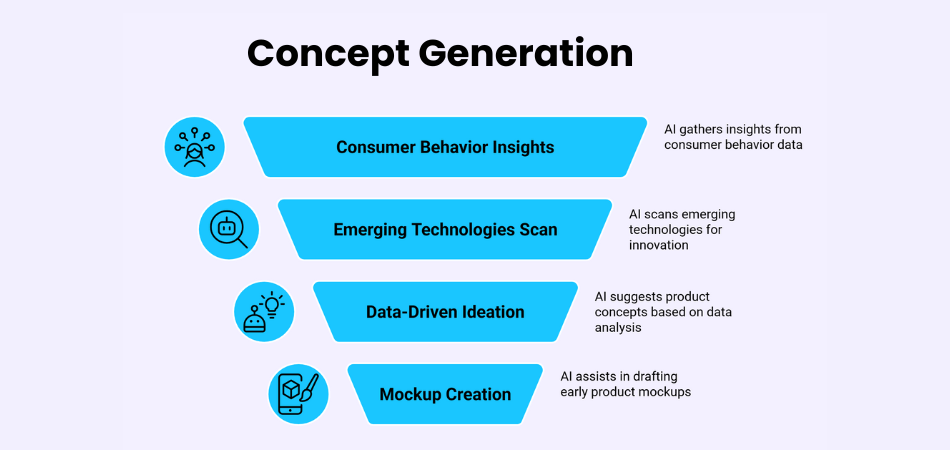
Industries Served:
Retail, automotive, electronics, and consumer tech industries benefit from faster concept ideation aligned with market needs.
How It Works:
AI tools analyze datasets—social media, reviews, patents, and competitor products—to suggest viable product concepts or features. Generative AI can also assist in drafting early product mockups or functional outlines.
Impact:
Speeds up brainstorming, ensures data-driven ideation, and aligns product vision with real-time market demand.
Real-World Example:
PepsiCo used AI to analyze flavor preferences and regional trends, helping them develop new snack variations tailored for specific markets.
2. Customer Feedback Analysis
AI can process and interpret large volumes of customer feedback to identify pain points, feature requests, and sentiment trends.
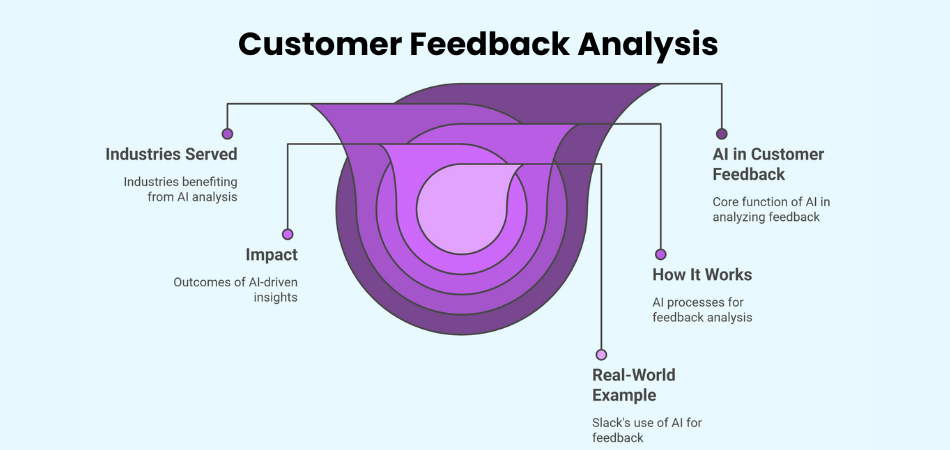
Industries Served:
E-commerce, SaaS, healthcare devices, and mobile apps use AI to enhance customer-centric product development.
How It Works:
Natural Language Processing (NLP) models analyze reviews, support tickets, surveys, and social media comments to surface key themes and satisfaction drivers.
Impact:
Gives product teams real-time insight into what users want, improving iteration cycles and reducing feature misalignment.
Real-World Example:
Slack uses AI to categorize and prioritize feedback from users, guiding feature updates and interface improvements.
3. Demand Forecasting
AI enhances the accuracy of demand forecasts, helping companies align production, marketing, and resource allocation.
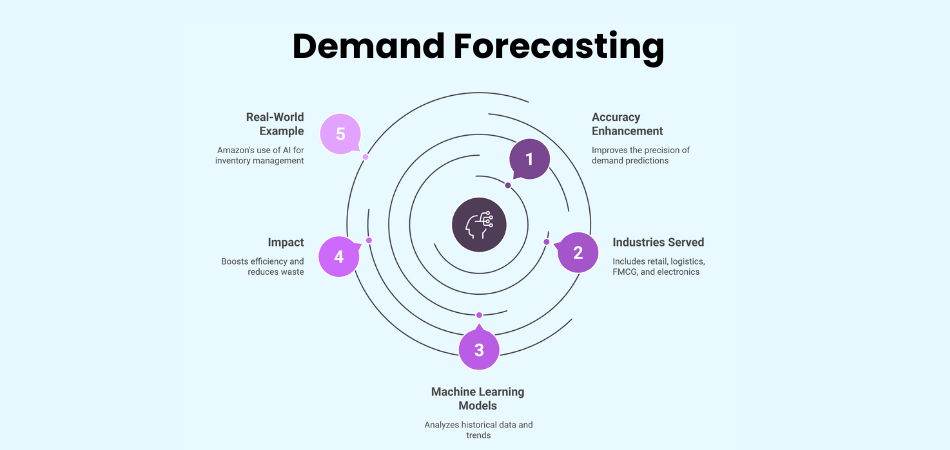
Industries Served:
Retail, logistics, FMCG, and electronics manufacturing rely heavily on this for reducing surplus and stockouts.
How It Works:
Machine learning models analyze historical sales data, economic indicators, seasonal trends, and real-time behavior to predict future product demand.
Impact:
Boosts production efficiency, reduces waste, and supports smarter inventory planning.
Real-World Example:
Amazon uses AI-powered demand forecasting to stock its warehouses accurately, reducing delivery time and costs.
4. Rapid Prototyping
AI accelerates the prototyping process by generating design alternatives and running simulations on performance and usability.
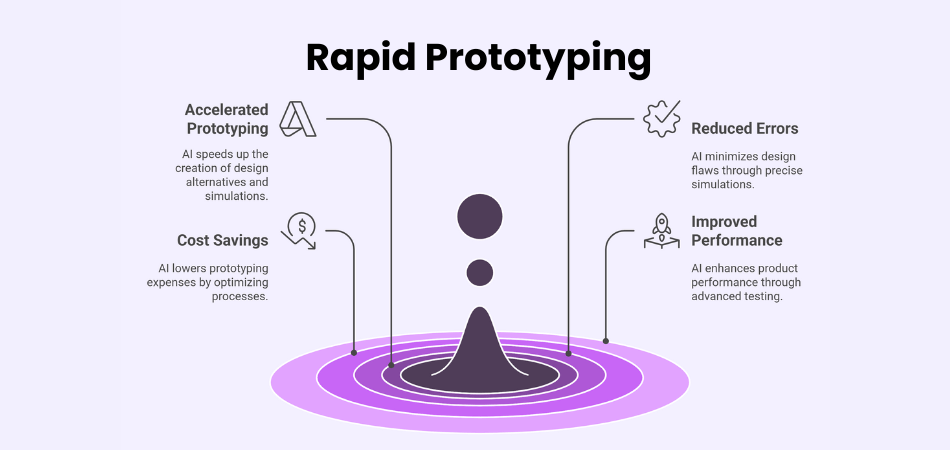
Industries Served:
Automotive, industrial design, consumer electronics, and wearable tech benefit from this speed and precision.
How It Works:
AI-based generative design tools create multiple prototype versions based on design goals, constraints, and material inputs. Simulations then test product behavior under various conditions.
Impact:
Shortens development cycles, reduces design errors, and cuts prototyping costs.
Real-World Example:
Airbus uses AI-driven generative design to prototype lightweight aircraft parts faster and with improved performance outcomes.
5. Materials Optimization
AI helps identify or design materials that best meet product requirements, such as durability, cost-efficiency, or sustainability.
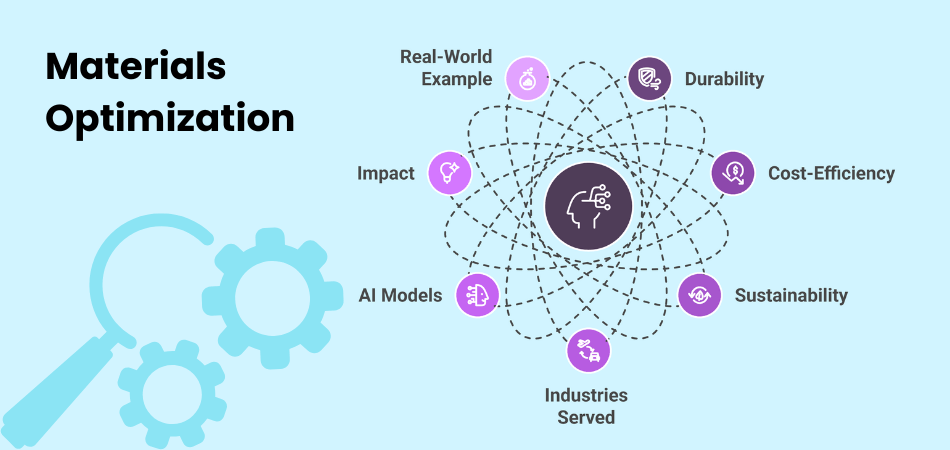
Industries Served:
Aerospace, automotive, packaging, and sustainable product companies leverage AI for material discovery and refinement.
How It Works:
AI models simulate how different materials will perform under specific conditions, using historical data and predictive modeling to suggest optimal choices.
Impact:
Improves product quality, reduces R&D time, and supports eco-friendly initiatives through smarter material use.
Real-World Example:
BASF, a chemical company, uses AI to develop and test new plastic materials that are both durable and recyclable.
6. User Experience Personalization
AI enhances UX by adapting interfaces and features based on individual user behavior and preferences.
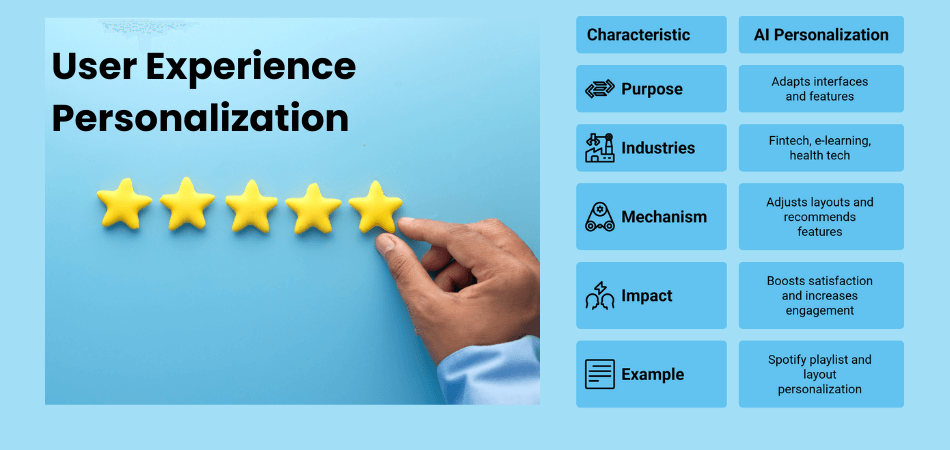
Industries Served:
Fintech apps, e-learning platforms, health tech, and consumer software products use personalization to boost engagement.
How It Works:
Behavioral data is fed into AI models that adjust layouts, recommend features, or change navigation paths to suit each user.
Impact:
Boosts user satisfaction, increases engagement time, and improves product retention.
Real-World Example:
Spotify uses AI to personalize playlists, app layout, and user suggestions, keeping listeners engaged based on their unique habits.
Implementing AI in Your Product Development Process
Successful AI implementation in product development requires a strategic approach. Begin by identifying specific pain points or opportunities in your current process. Focus on areas where AI can provide the greatest impact rather than implementing technology for its own sake.
Start with pilot projects that demonstrate value quickly. These projects build organizational confidence and provide learning opportunities. Furthermore, pilot projects help identify integration challenges before full-scale implementation begins.
Develop clear metrics for measuring AI impact on product development outcomes. These metrics might include cycle time reduction, cost savings, or innovation quality improvements. Regular measurement ensures that AI investments deliver tangible business value.
Address organizational and cultural factors that influence AI adoption. Provide training and support for team members working with new AI tools. Additionally, create clear guidelines for human-AI collaboration to maximize the strengths of both.
Implement a phased approach that gradually expands AI capabilities across the product development process. This approach allows teams to adapt to new workflows and technologies without disruption. Moreover, it enables continuous learning and improvement of AI implementation strategies.
Step-by-Step AI Implementation Guide
Implementing AI in product development requires careful planning and execution. The following steps provide a structured approach to successful integration of AI capabilities into existing product development processes.
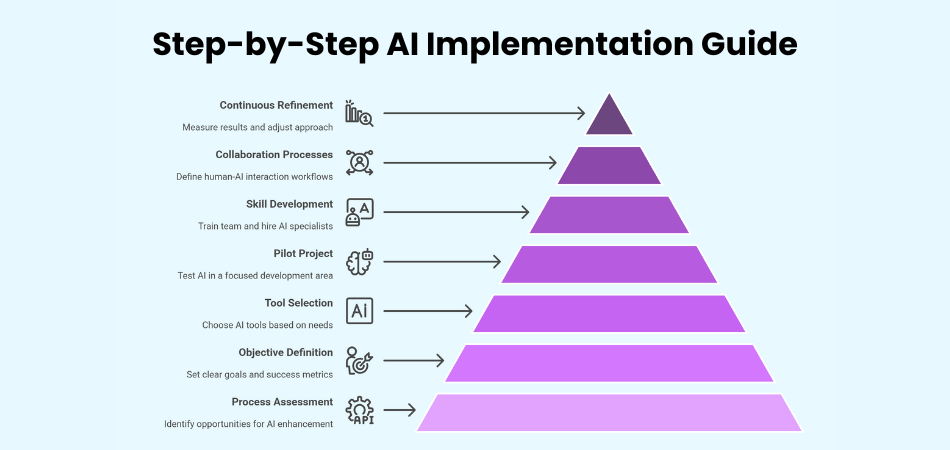
- Assess current processes and identify opportunities by mapping your product development workflow and identifying bottlenecks, time-consuming tasks, and decision points that could benefit from AI enhancement.
- Define clear objectives and success metrics for AI implementation, focusing on specific outcomes like reducing concept development time by 30% or increasing successful product launches by 25%.
- Select appropriate AI tools and technologies based on your specific needs, considering factors like integration capabilities with existing systems, scalability, and required technical expertise.
- Start with a focused pilot project in one area of product development, such as concept generation or customer feedback analysis, to demonstrate value and learn from implementation challenges.
- Develop necessary skills and capabilities within your team through training programs, hiring specialists, or partnering with external experts who can guide implementation efforts.
- Create clear processes for human-AI collaboration that define when AI tools should be used, how outputs should be evaluated, and how decisions will be made based on AI recommendations.
- Measure results against established metrics and continuously refine your approach based on outcomes, user feedback, and emerging best practices in AI-enhanced product development.
This structured implementation approach helps organizations maximize the benefits of AI while minimizing disruption to existing product development processes.
Note
- Ensure data quality before implementing AI tools, as poor data leads to poor results.
- Balance AI automation with human oversight to maintain product quality and innovation.
- Start with simpler AI applications before moving to more complex implementations.
- Regularly review ethical implications of AI use in your product development process.
Overcoming Challenges in AI-Powered Product Development
Despite its potential, implementing AI in product development presents several challenges. Data quality and availability often limit AI effectiveness. Many organizations lack sufficient historical data for training accurate models. Furthermore, existing data may contain biases that affect AI outputs.
Integration with existing tools and processes creates technical challenges. Product development teams typically use multiple specialized tools that may not easily connect with AI systems. This fragmentation can reduce the effectiveness of AI implementations and create workflow disruptions.
Skill gaps present significant obstacles to effective AI adoption. Product teams may lack the technical expertise needed to implement and manage AI systems. Additionally, data scientists may not understand product development processes well enough to create effective solutions.
Organizational resistance can undermine AI implementation efforts. Team members may fear job displacement or loss of creative control. Moreover, traditional development processes may be deeply embedded in organizational culture and difficult to change.
Ethical considerations also present challenges in AI-powered product development. Issues include algorithmic bias, data privacy concerns, and appropriate levels of automation. Organizations must develop clear guidelines for responsible AI use in product development contexts.
Strategies for Successful AI Integration
Overcoming implementation challenges requires deliberate strategies. Create cross-functional teams that combine product development expertise with AI technical knowledge. These teams bridge the gap between domain knowledge and technical implementation.
Invest in data infrastructure that supports AI applications. This infrastructure includes data collection, storage, cleaning, and management capabilities. Additionally, develop processes for ensuring data quality and addressing potential biases.
Implement change management strategies that address organizational concerns about AI adoption. Communicate clearly about how AI will augment human capabilities rather than replace them. Furthermore, involve team members in implementation planning to build ownership and acceptance.
Develop clear governance frameworks for AI use in product development. These frameworks should address data privacy, ethical considerations, and decision-making authority. Moreover, they should establish processes for monitoring AI system performance and addressing issues.
Create continuous learning mechanisms that capture insights from AI implementation. Regular reviews of AI performance help identify improvement opportunities. Additionally, sharing success stories builds organizational confidence in AI-enhanced product development.
Measuring ROI and Impact of AI in Product Development
Quantifying the return on investment for AI in product development requires comprehensive measurement approaches. Direct metrics include development cycle time reduction, cost savings, and quality improvements. For example, companies implementing AI report average development time reductions of 30-50%.
Indirect benefits include increased innovation capacity, improved market responsiveness, and enhanced competitive positioning. These benefits may be harder to quantify but often provide greater long-term value. Furthermore, AI enables product teams to explore more design options and make better-informed decisions.
Implement a balanced scorecard approach that captures both quantitative and qualitative impacts. This approach should include metrics across multiple dimensions, including process efficiency, product quality, market performance, and organizational capability. Regular measurement provides insights into AI effectiveness and improvement opportunities.
Consider time-based ROI calculations that account for the evolving nature of AI capabilities. Initial implementations may deliver modest returns while establishing foundational capabilities. However, returns typically increase as organizations develop greater AI maturity and expand implementation scope.
| Metric Category | Specific Measurements | Typical Impact |
| Process Efficiency | Development cycle time, Resource utilization, Number of iterations | 30-50% reduction in development time |
| Product Quality | Defect rates, Customer satisfaction, Feature adoption | 25-40% improvement in quality metrics |
| Innovation Impact | Number of concepts explored, Patent applications, Novel features | 3-5x increase in design options explored |
| Market Performance | Time to market, Revenue growth, Market share | 20-35% reduction in time to market |
| Cost Efficiency | Development costs, Material usage, Manufacturing efficiency | 15-30% reduction in overall costs |
Future Trends in AI-Powered Product Development
The evolution of AI in product development continues at a rapid pace. Emerging technologies like multimodal AI will enable more sophisticated product design capabilities. These systems combine text, image, and other data types to generate more comprehensive design solutions.
Autonomous design systems represent another significant trend. These systems will increasingly handle routine design tasks with minimal human intervention. However, human designers will remain essential for creative direction and contextual understanding.
Edge AI deployment will bring artificial intelligence capabilities directly into design tools and manufacturing equipment. This approach reduces latency and enables real-time AI applications in product development. Furthermore, it allows AI to function in environments with limited connectivity.
Collaborative AI systems will enhance human-machine partnerships in product development. These systems learn from human designers and adapt to their preferences and working styles. Additionally, they provide increasingly relevant suggestions as collaboration continues.
Responsible AI frameworks will become standard in product development. These frameworks address ethical considerations, bias mitigation, and appropriate automation levels. Moreover, they ensure that AI enhances human creativity rather than constraining it.
Conclusion
AI in product development represents a fundamental transformation. Organizations that strategically implement AI are achieving major gains in speed, quality, and innovation. These technologies are also enabling smaller companies to compete more effectively in global markets. Success requires balancing AI with human expertise, combining their strengths. Organizations must also address data quality, integration, and skill development to maximize AI benefits. As AI evolves, product development will become more intelligent and responsive. Those building strong AI foundations now will be best positioned to lead tomorrow.
Ashikul Islam
Ashikul Islam is an experienced HR Generalist specializing in recruitment, employee lifecycle management, performance management, and employee engagement, with additional expertise in Marketing lead generation, Content Writing, Designing and SEO.
Related Post
Top 10 AI Development Companies in New Jersey for Business
Are you searching for the perfect AI development partner in New Jersey? Have you wondered which...
Top 10 AI Development Companies in New Hampshire
Are you watching New Hampshire’s tech landscape transform before your eyes? Your state is quietly becoming...
Top AI Companies in Nebraska Every Business Should Know
Are you a Nebraska business owner wondering how artificial intelligence could transform your operations? Picture this...

